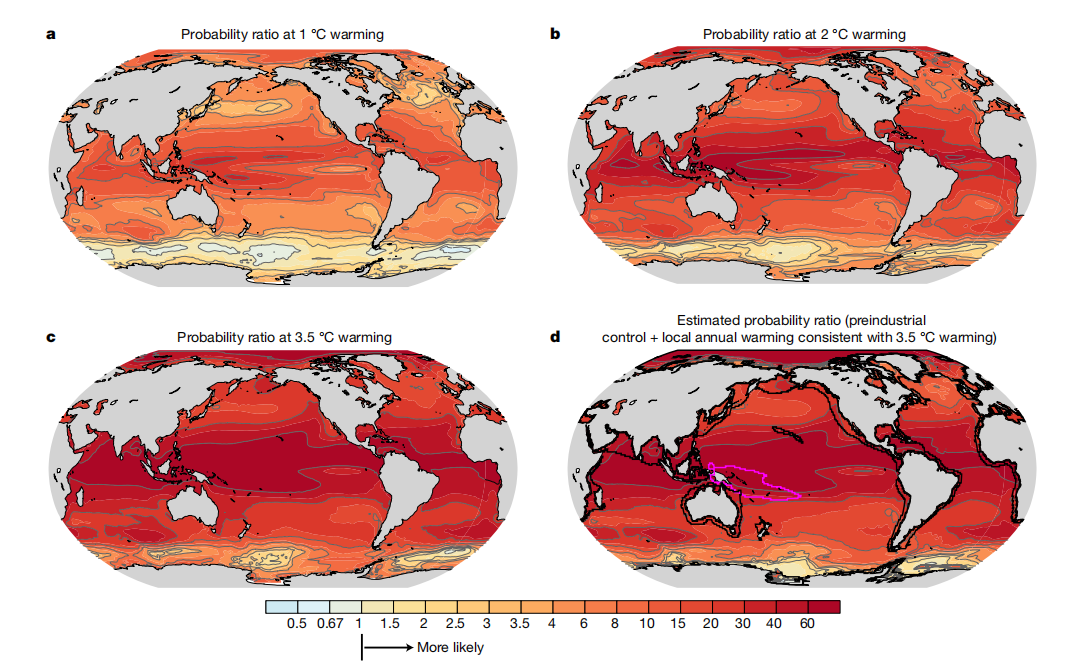海洋热浪(MHWs)是指海面温度持续数天至数月并可延伸数千公里的极端温暖时期,MHWs事件造成了生物生产的变化、有毒藻类的大量繁殖、珊瑚礁群落结构的变化、珊瑚的大规模白化和大量底栖海洋生物群落死亡,对经济和社会产生了连锁影响。
Marine heatwaves (MHWs) are periods of extreme warm sea surface temperature that persist for days to months. MHWs have caused changes in biological production, toxic algal blooms, regime shifts in reef communities, mass coral bleaching and mortalities of commercially important fish species, with cascading impacts on economies and societies.
越来越多的证据表明,全球变暖正在导致陆地上出现更频繁、更强烈的热浪,增加了发生严重影响的风险。在某些情况下,这种影响是不可逆转的。相比之下,对海洋中的热浪是如何及时展开的以及相关影响是什么知之甚少,对其潜在的驱动因素以及它们在多大程度上可归因于全球变暖,目前尚不十分清楚。考虑到海洋生态系统和渔业以及人类社会对这类事件的高度脆弱性,这种知识差距令人相当关切。
There is mounting evidence that global warming is leading to more frequent and intense heatwaves over land, increasing the risk of severe and in some cases irreversible impacts. In comparison, we know much less about how heatwaves in the ocean unfold in time and what the associated impacts are. Although there is a rapidly growing literature on individual events, the underlying drivers and the degree to which they can be attributed to global warming are currently not well known. This knowledge gap is of considerable concern given the high vulnerability of marine ecosystems and fisheries, but also human societies, to such events.
2018年,来自伯尔尼大学气候与环境物理研究所的Frölicher等人在《Nature》上发表了一篇名为“《全球变暖下的海洋热浪》”的研究论文。作者利用(i)覆盖1982-2016年期间的遥感日全球海表温度(SST)数据和(ii)覆盖1861-2100年期间的12个全耦合全球地球系统模型(ESMs)的日输出检测不同海洋热浪特征的过去变化并评估未来变化。
In 2018, Frölicher et al. from the Institute of Climate and Environmental Physics at the University of Bern published a paper in Nature entitled "Marine heatwaves under global warming".They detect past changes and assess future ones in different MHW characteristics using (i) remotely sensed daily global sea surface temperature (SST) data covering the period 1982–2016, and (ii) daily output from twelve fully coupled global Earth system models (ESMs) covering the period 1861–2100.

图1 在不同的全球变暖水平下,MHW天数的区域变化。
Fig1 Regional changes in probability of MHW days for different global warming levels.
在卫星数据采集期间观察和建模了MHWs特征在35年中的变化趋势,发现卫星观测与模拟的趋势具有相似的幅度。假设基于模型的内部变率估计是准确的,研究得出一个高置信度的结论,即观测到的海洋热浪日数、最大强度和空间范围的趋势在很大程度上是由长期海洋变暖引起的。支持这一结论的事实是,海表温度的变化对不同海洋热浪特征的年变化也有很大影响。
Trends in the characteristics of MHWs over 35 years are observed and modeled during satellite data acquisition, and satellite observation results and simulated trends are found to have similar magnitudes. Assuming that the model-based estimates of internal variability are accurate, the study concludes with a high degree of credibility that the number of days, maximum intensity, and spatial extent of marine heatwaves are due in large part to long-term ocean warming. What can support this conclusion is the fact that changes in sea surface temperature also have a strong influence on the annual changes of different marine heatwaves characteristics.
据预测,MHWs的概率几乎在所有地方都将增加,这种增加在热带和北冰洋中最大,在南大洋中最小。在热带地区,特别是西太平洋暖池中发生大概率变化的主要原因是这些地区海温的变化,无论是季节性的还是年与年的变化。在北冰洋,全年海冰以下的海温变化非常小。这与南大洋形成对比,南大洋的表层海水预计将保持相对凉爽,因此在所有变暖水平下,MHWs发生概率不会增加太多。沿海大型海洋生态系统中MHWs概率的预计增加幅度与2℃变暖下的全球增加幅度相似。
The probability of MHWs is projected to increase almost everywhere, and the increase is largest in the tropics and the Arctic Ocean and smallest in the Southern Ocean. The main reason for the large changes in probability in the tropics, and especially in the western Pacific warm pool, is the small variations in SST in these areas, both seasonally and from year to year. As a result, the same changes in annual mean SST lead to much larger changes in the probability of exceeding the 99th percentile. The same applies to the Arctic Ocean, where SST variations below year-round sea ice are very small. This is in contrast to the Southern Ocean, where surface waters are projected to stay relatively cool, and therefore the probability ratio does not increase much under all warming levels. The projected increase in the probability of MHWs in the coastal large marine ecosystems has similar magnitude to the global increase under 2 °C warming.
对于未来和所有的海洋盆地,ESMs预测了更频繁、更广泛、更强烈和更持久的MHWs(这里的参考时期回到前工业时代)。这些变化的幅度随全球平均温度和导致全球变暖的累积二氧化碳排放的变化而变化。对于3.5℃的变暖,发生大规模海洋热浪事件的概率是工业化前时代的41倍。换句话说,在工业化前水平上百日一遇的海洋热浪事件在这一全球变暖水平上预计将变成三天一遇的事件。年平均的空间范围预计将增加21(15-29)倍,持续时间将增加到112天(92-129天),其最大强度将上升到2.5℃(2.1-2.9℃)。如果升温控制在2℃以下,甚至1.5℃以下,这些不同MHW特征的大幅增加将大幅减少。在1.5℃变暖情景下发生大规模巨灾的概率仅为3.5℃变暖情景下的40%。
For the future and all ocean basins, the ESMs project more frequent, extensive, intense and longer-lasting MHWs (here the reference period is set back to preindustrial times). The magnitude of these changes scales with the global mean temperature and the cumulative CO2 emissions that drive this global warming. For 3.5 °C warming, the probability of occurrence of an MHW is 41 times higher than in preindustrial times. In other words, a one-in-a-hundred-days event at preindustrial levels is projected to become a one-in-three-days event at this level of global warming. The spatial extent of the annual mean is projected to become 21 (15–29) times larger, its duration to increase to 112 days (92–129 days), and its maximum intensity to rise to 2.5 °C (2.1–2.9 °C). These large increases in the different MHW characteristics are substantially reduced if warming is kept below 2 °C, or even below 1.5 °C. The probability of occurrence for an MHW under the 1.5 °C warming scenario is only 40% of that under 3.5 °C warming. The relative change in the spatial extent of a typical MHW would be 25%, the duration 35% and the maximum intensity 45% of those at 3.5 °C.

图2卫星数据采集期间,MHW特征的观测和模拟趋势。
Fig2.Observed and modelled trends in MHW characteristics over the satellite data taking period.
由于随着变暖概率比的大幅增加,在目前1℃的变暖水平下,可归因风险(即人为对事件发生概率的贡献)的模拟分数已达到0.87,这意味着(假设模型以保真度模拟自然发生的MHWs),目前发生的87%的MHWs(相对于工业化前条件定义的)可归因于全球变暖。由于这种变暖主要是由温室气体的人为排放造成的,因此人类活动与模拟的巨巨物质增加之间存在直接联系;这支持了我们从卫星数据中得出的结论。显然,任何具体的大规模生物多样性事件仍然源于气候系统的自然变率,但目前的全球变暖水平大大增加了发生大规模生物多样性事件的几率。在2℃时,归因风险的模拟分数已经接近1(0.94-0.97),这意味着在这个或更高的变暖水平上,基本上所有MHWs都是由人为变暖造成的。
Because of the large increase in the probability ratio with warming, the simulated fraction of attributable risk—that is, the anthropogenic contribution to the probability of an event—reaches 0.87 (0.78–0.91) already under a present-day level of 1 °C warming. This implies (under the assumption that the models simulate naturally occurring MHWs with fidelity) that 87% of the currently occurring MHWs (defined relative to preindustrial conditions) can be attributed to global warming. Because this warming is primarily driven by anthropogenic emissions of greenhouse gases, there is a direct link between human action and the simulated increase in MHWs; this supports our conclusion drawn from the satellite data. Clearly, any specific MHW event still arises from the natural variability in the climate system, but the present-day level of global warming has substantially increased the odds of an MHW to occur. The simulated fraction of attributable risk approaches unity (0.94–0.97) already at 2 °C, implying that essentially all MHWs are due to anthropogenic warming at this or higher levels of warming.
MHWs数量的增加可能会对海洋生物产生严重、普遍和持久影响的风险,特别是对那些流动性较差和脆弱性较高的生物,如珊瑚礁和生活在低纬度地区的生物,那里的许多海洋物种生活在接近其高温上限的地方。然而,由于物种和系统特异性反应,海洋生物和生态系统对MHWs的反应可能是可变的,难以预测。因此,迫切需要更好地了解海洋生物和生态系统对MHWs和其他压力源中的极端事件的响应,以评估全球变暖对海洋生物和生态系统的全面风险。
An increase in MHWs will probably increase the risk of severe, pervasive and long-lasting impacts on marine organisms, especially on those with reduced mobility and high vulnerability, such as coral reefs, and those living at low latitudes, where many marine species live close to their upper thermal limits. However, the responses of marine organisms and ecosystems to MHWs can be variable and difficult to predict owing to species- and system-specific responses. Therefore, better understanding of the response of marine organisms and ecosystems to MHWs and extreme events in other stressors is urgently needed to assess the full risk for marine organisms and ecosystems under global warming.
参考文献:https://doi.org/10.1038/s41586-018-0383-9
 公众号
公众号